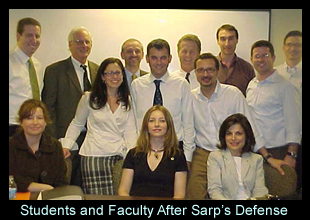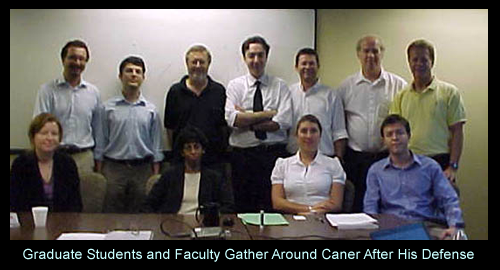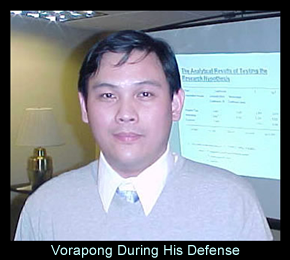During the Spring 2009 semester, three students successfully defended their doctoral investigations into environmental and energy research areas.
Vorapong Manowan
On February 27, 2009, Vorapong Manowan defended his dissertation research project entitled “Awareness and Management of Hospital Waste in Developing Countries: A Case Study in Thailand.” In his research, Vorapong assessed hospital waste management processes in healthcare industries and identified factors affecting the management of hospital wastes in developing countries; compared standard criteria for hospital waste management in Europe, the United States and selected developing countries; and developed a hospital waste management paradigm for developing countries, using Thailand as an experimental vehicle for testing his hypotheses.
Among his findings are the fact that hospital size, type, knowledge levels of staff, organizational policies and strategies play major roles in hospital waste management systems in developing counties.
While most developed countries have legal provisions with regard to proper management of hazardous wastes, hospital waste management systems in developing countries often do not properly dispose of infectious and other hazardous wastes effectively. Major elements in the hospital waste management paradigm developed by Vorapong include segregation, handling, transportation and disposal of infectious waste.
Sarp Yeletaysi

On April 29, 2009, Sarp Yeletaysi defended his dissertation research project entitled “An Operational Impact Analysis on the Continuity of the Petroleum Supply Chain Using GIS and Systems Simulation.”
Sarp’s study was motivated by the fact that the risk of a major disruption to the U.S. petroleum infrastructure is high. Understanding, quantifying, and dealing with this risk necessitates the amalgamation of knowledge and techniques from several disciplines and research domains. Some of those domains are critical infrastructure analysis, risk analysis, systems simulation, geographic information systems, and petroleum supply chain management.
The objective of Sarp’s study was to develop a framework to explore and quantify risk of disruptions in the U.S. petroleum supply chain caused by hurricanes. The analysis was based on numerical and empirical data collected during Hurricanes Katrina and Rita. A semi-continuous supply chain simulation model of the petroleum supply chain was designed and implemented. Failure and recovery of critical petroleum supply chain components was modeled with input distributions dictated by real data. A Geographic Information System (GIS) was employed for better management of spatial data, face-validation of supply chain elements, estimation of distances between modeled infrastructures, and improved overall visualization of the system. A Monte Carlo simulation at its steady state was run with the inclusion of the failure/recovery models. Output statistics representing key system performance measures and status of infrastructure components were collected for three scenarios. Scenario outputs were compared and interpreted for their overall significance.
Sarp’s research contributes to the body of knowledge in risk modeling of the petroleum supply chain during disasters. It demonstrated the amalgamation of multiple methodologies from different streams of research thus made a direct contribution to the domain of interdisciplinary applied science. It made a first attempt to quantify the uncertainty associated with the possibility of petroleum product shortages during and after hurricanes. The research established a descriptive framework that fosters a more factual discussion of inherent petroleum supply chain risks. By defining standardized performance metrics and relying on an extensible and flexible simulation model, Sarp’s results ensure an objective comparison of multiple disaster scenarios.
Adil Caner Sener

On June 12, 2009, Caner Sener defended his dissertation research project entitled “Uncertainty Analysis of Geothermal Energy Economics.” In his research, Caner applied geothermal energy economics to assess and quantify uncertainties associated with the nature of geothermal energy and energy investments. The study introduced a stochastic geothermal cost model and a valuation approach for different geothermal power plant development scenarios. The Monte Carlo simulation technique was employed to obtain probability distributions of geothermal energy development costs and project net present values.
One of the goals of Caner’s investigation was to shed light on the longtime standing modeling problem of dependence modeling between random input variables. The dependence between random input variables was modeled by employing the method of copulas. The study focused on four main types of geothermal power generation technologies and introduced a stochastic levelized cost model for each technology. He also compared levelized costs of natural gas combined cycle and coal fired power plants with geothermal power plants.
The second part of Caner’s study introduced a stochastic discounted cash flow valuation model for the geothermal technologies analyzed in the first phase. In this phase of the study, the Integrated Planning Model (IPM) software was used to forecast the revenue streams of geothermal assets under different price and regulation scenarios. Those results were then combined to create a stochastic revenue forecast of the power plants. The uncertainties in gas prices and environmental regulations was modeled and their potential impacts captured in the valuation model. Finally the study compared the probability distributions of development cost and project value and discusses the market penetration potential of the geothermal power generation.
There is a recent world wide interest in geothermal utilization projects. There are several reasons for the recent popularity of geothermal energy such as increasing volatility of fossil fuel prices, need for domestic energy sources, approaching carbon emission limitations and state renewable energy standards, increasing need for baseload units and new technology to make geothermal energy more attractive for power generation. Caner’s research will contribute to the recent progress of geothermal energy by shedding light on the uncertainty of geothermal energy project costs.


